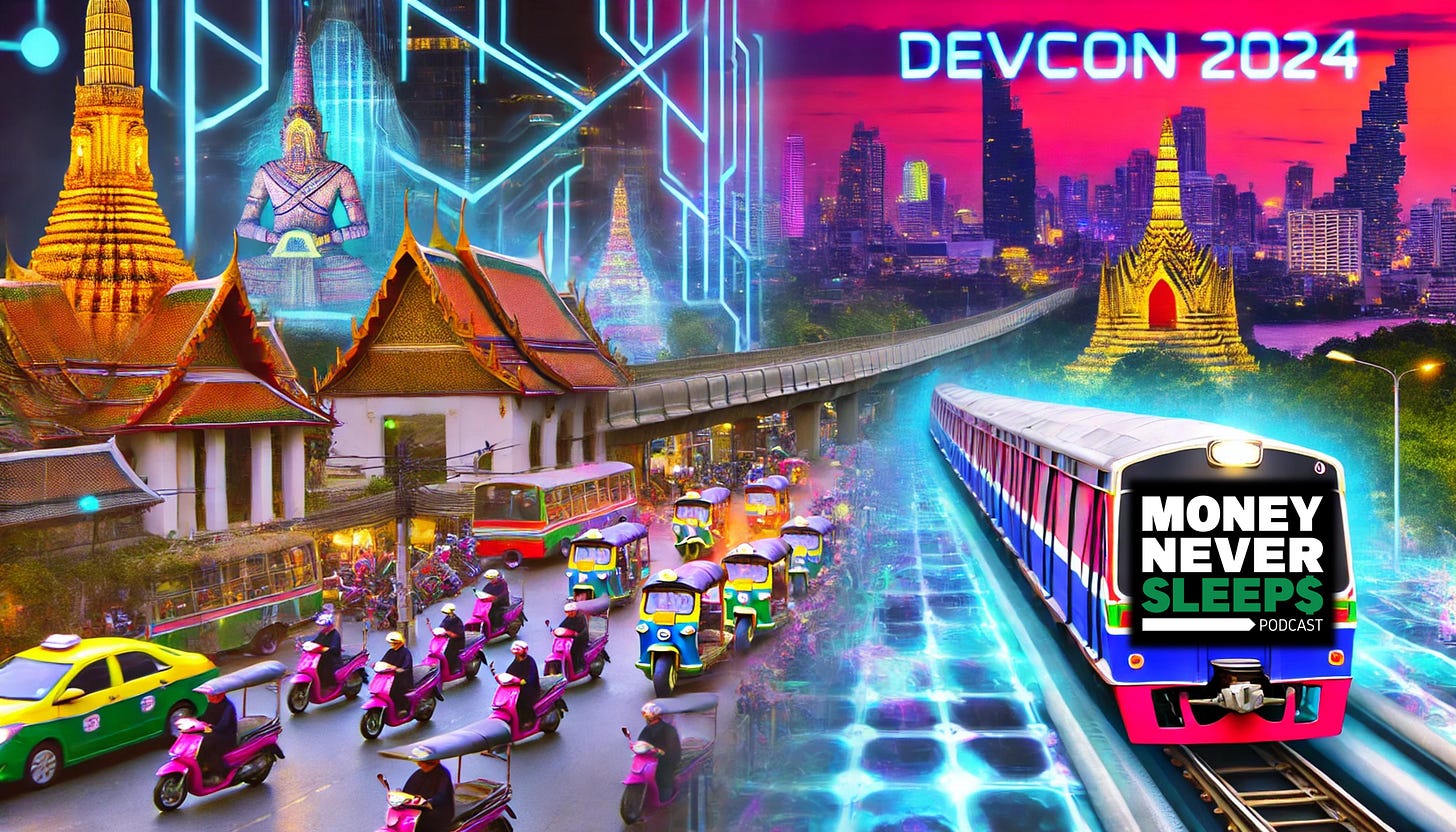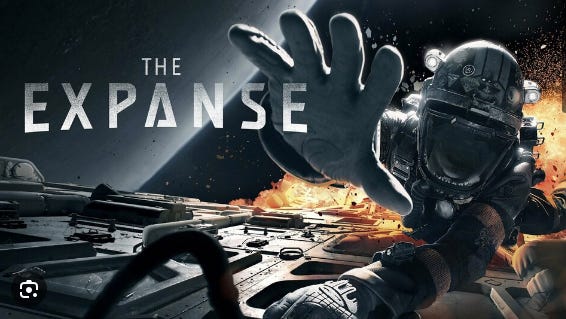Before diving into what happened this week, this is just a quick ask: if you're enjoying this newsletter, please share it with friends!
Investing in Web3
As many of our listeners and readers know, I lead the Techstars Web3 accelerator, investing in entrepreneurs building in web3 and enabling the next wave of growth in the decentralized internet and in tokenized economies. Applications have now closed for our Spring 2025 class, but drop me a line here if you’d like to hear more about the core benefits of the program for web3 founders - mentorship, network, and investment - or meet our alumni who are currently raising.
👉Follow Techstars Web3 for updates: X (Twitter) | Farcaster | LinkedIn
The Expanse of Bangkok
Although I’ve only seen a couple of episodes of The Expanse, something about Bangkok made me think of the show where you’ve got people from all over the solar system 200 years in the future just trying to get from point A to point B.
Here are my 5 takeaways from my 120-hour door-to-door journey from Dublin to Bangkok and back again for the DevCon 2024 conference:
1 - The Journey
Don’t do what I did - 40 hours of traveling in 120 hours away from home. Thankfully, all four legs of my journey (Dublin-Dubai, Dubai-Bangkok, Bangkok-Dubai, Dubai-Dublin) were bang on time. If I were to do this again, whether it be Bangkok or another city that takes 15-16 hours to reach, I’d stay longer - maybe 7-8 days.
2 - The People
The people I met along the way - taxi drivers, train station agents, wait staff, hotel staff, anyone who pointed me in the right direction - were just so incredibly friendly and helpful No matter where I was trying to go, someone was always willing to do their best to help me.
3 - The City
The blend of the old and the new was just striking - so much modern architecture alongside old ramshackle buildings, sort of like a love child of NYC and Hong Kong with a twist of Singapore. Navigating all of this on the trains and in taxis was sluggish at best, especially with the 34 degrees Celsius (93 F) heat. It takes 45-minutes to an hour to get anywhere in the city unless you like arriving a sweaty mess or putting your life in someone else’s hands and feet on the back of a scooter.
This is a list of 5, but it could easily be 6 with the food - I was in heaven with the Thai cuisine.
4 - The Conference
In contrast to the sales and marketing-focused Token2049 Singapore, DevCon 2024 had a different feel, and it’s in the name (‘dev’). As it’s Ethereum-focused, DevCon attracts a lot more pure builders/developers, which is exactly why I went, as I’m looking for the next bunch of fantastic founders to invest in via the Techstars Web3 accelerator.
Job done. I ended up with about 30 new candidates (I met them all at side-events), and as in-person meetings are 10x more effective than virtual, you get 10x the work done by being there. Southeast Asia is a hotbed of web3 activity right now, and a massive gathering in Bangkok (or arguably Singapore, but more buttoned-up) seemed like the right place to be at the epicenter of the tectonic shift underway.
5 - The Side-Events
One site listed 930 side-events from 11-17th November related to DevCon. Seriously.
However, the side-events are where everything happens - they’re more intimate and you’re always going to fall into the random conversations that don’t tend to happen at the actual conference.
Once you register for an event on Luma (everyone uses this), you can see who’s signed up and pick which ones you’ll attend based on who you want to meet. I was deciding on side events based on triangulating the time, location, expected attendees (builders vs investors, or both), sponsors and organizers.
But as you register for 4-5 side-events per day, no one really knows for sure where anyone else will be. Five minutes before you head in one direction to a side-event, you might learn about an event that sounds better and the whole direction of your day and night changes.
I was only at the actual DevCon venue for 2 hours on Wednesday and 2 hours on Thursday, both for specific meetings. The one panel I did attend though in support of a friend on-stage was surprisingly not the empty venue I had expected - even with everyone at side-events!
Note to organizers of any side-event - always invite 3x the capacity of the event if you want to fill the room. Only a third of registered attendees ever turn up.
Where to next?
Nowhere. We’ve got over 600 applications to review from web3 founders interested in Techstars mentorship, network and investment in 2025, so I’ll be right here at home for the foreseeable future!
This Week’s Podcast
This week, we’re diving into the ultimate fundraising playbook for web3 startups. This isn’t just a checklist—it’s the real, hard-hitting truth about what it takes to secure that critical first round of funding in web3.
This week’s episode comes from a breakout session I hosted at a Techstars event, designed to help founders navigate the maze of fundraising in web3. Spoiler alert: fundraising is hard, and web3 fundraising? Even harder. But with the right mindset and a plan that’s rock-solid, you might just win the game. Let’s break it down.
The Fundraising Mission
Fundraising is a campaign—it’s intense, time-consuming, and will test every ounce of your resilience. As a founder, you’re running two full-time jobs: managing your business and executing your fundraise.
The table stakes? Be in the top 10% of investable ventures in your category. Ask yourself honestly—does your product, story, and plan make you a no-brainer investment?
The Basics
How Much to Raise (Pre-Seed/Seed)?
Small raises (<$1M) can close faster but appeal to fewer investors.
Larger raises ($3–5M) attract big pre-seed/seed investors but require traction and a razor-sharp plan to back it up.
Who to Target?
Know your audience: angels, VCs, launchpads, ecosystems.
Web2 investors dipping into web3 will care about different things than web3 native investors.
Lawyer Up.
In web3, your legal structure can make or break you. Whether you’re issuing tokens, equity, or both, your legal docs must be airtight.
Building the Machine
Fundraising success depends on preparation and precision:
1. Build Your Narrative
Your story needs to inspire. Answer these questions:
What problem are you solving?
How does your solution uniquely fit, and who’s it for?
Why are you different, and why now?
How will you get it to market?
Why is your team the best positioned to deliver this?
Where will you be in 12–18 months with this funding?
2. Create Your “House of Paper”
One-pager: Your problem, solution, traction, and ask on one page.
Deck: One version to send, another for live pitches. Keep it clear, concise, and 20pt font minimum for the pitch version!
Litepaper-Whitepaper-Tokenomics (if applicable): This is where the heavy lifting happens. Get some help to get it right.
3. Build Your Pipeline
Identify at least 100 target investors.
Use warm intros—founders they’ve backed are your best allies.
Tier them (A, B, C) and pitch in reverse order to refine your approach.
4. Go Social
Talk to everyone—founders, friends, family, even your dog. Gather feedback, adjust your plan, and widen your network.
Execution: The Final Frontier
Here’s the kicker—you’ll hear “no” 95 times out of 100. Learn to love the no because it gets you closer to the right fit.
Lead Investors: Finding the lead is critical; they set the tone for the round. You may be able to influence a “follow” investor into a “lead”, but not always.
Event Strategy: Attending conferences? Plan ahead. Side events are often where the magic happens. Don’t go without a plan, it’s a crapshoot otherwise.
Close Fast: Aim for 20 investor calls a week over 6–8 weeks. Keep the momentum.
The Fine Print
Beware of the landmines:
Launchpads and Market Makers: Read every word of the contract, twice. And a third time with your lawyer.
Regulatory Considerations: If you’re adding a token, ensure it’s necessary. Don’t try to make a loyalty program sound like a decentralized network.
Final Thoughts
Fundraising in web3 isn’t for the faint of heart. But with the right preparation, resilience, and focus, you’ll find yourself well on the path to building something extraordinary.
Want to learn more? Check out the show notes at MoneyNeverSleeps for the slides and video recording from the session (also below), plus additional resources like pitch deck templates and tokenomics examples.
If you like what you heard, drop us a rating on Apple Podcasts or Spotify—it helps others find the show.
Until next time, keep building and keep hustling.
🎧Don’t forget to follow MoneyNeverSleeps on Spotify or Apple Podcasts to get each episode freshly delivered to your podcast queue!
X-Post (Tweet!) of the Week
Sharing Dealflow
Many of the alumni from the Techstars Web3 Class of 2024 are currently fundraising, and you can check out the Airtable here for details on all of the companies/projects. If you’re investing in early-stage web3 companies/projects, let me know which of the Techstars Web3 grads look interesting to you!
See ya!
Thanks for reading, and don't forget to tune in to our next episode!
Pete 🎸
Links:
✅Leave a review and subscribe on Apple Podcasts | Spotify
🙏Check out our MoneyNeverSleeps website
📣Follow us on X(Twitter): Pete Townsend | MoneyNeverSleeps
📣Follow us on LinkedIn: Pete Townsend | MoneyNeverSleeps








